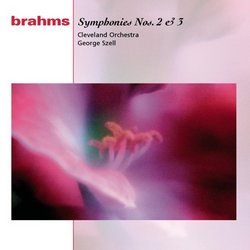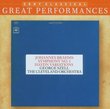| All Artists: Brahms, Szell, Cleveland Orchestra Title: Symphonies 2 & 3 Members Wishing: 1 Total Copies: 0 Label: Sony Release Date: 1/3/1992 Genre: Classical Styles: Historical Periods, Modern, 20th, & 21st Century, Symphonies Number of Discs: 1 SwapaCD Credits: 1 UPC: 074644765229 |
Search - Brahms, Szell, Cleveland Orchestra :: Symphonies 2 & 3
 | Brahms, Szell, Cleveland Orchestra Symphonies 2 & 3 Genre: Classical
|
Larger Image |
CD DetailsSimilar CDs |
CD ReviewsSymponic dissapointment duffyl17 | 03/30/2004 (3 out of 5 stars) "Generally speaking Szell tends to convice through his ear for balance rather then seeking warmth...the Cleveland orchestra for the most part are given a recording that is dry and dessicated. Woodwind solos are generally good but with little or not inflection and nuance. I was very dissapointed with the slow movement of Symphony no. 2...it was rather plodding and too straighforward. William Steinberg in Pittsburgh was much more involving and committed. I have found too many people quick to find the right set of Brahms records...Sanderling is my first choice in terms of warmth of phasing and passion. Although his tempos are a bit slower...he doesn't allow the Dresden Statskappelle to gloss over the Brahms symphonies like Cleveland does here....Don't get me wrong, I think Szell is good, but as I get older I realize the well-oiled Cleveland machine under Szell is a bit like kissing the chrome plating on the bumper of a Cadillac!!!" Exploring the Brahms Symphonies -- Nos. 2 and 3 Robin Friedman | Washington, D.C. United States | 02/17/2005 (5 out of 5 stars) "I have been listening to a great deal of Brahms in the process of reading the musical biographies by Malcolm Macdonald and Jan Swafford. I took the opportunity to revist the Brahms second and third symphonies in the performances by George Szell and the Clevland Orchestra. These performances are strongly conducted as Szell shapes the scores as a whole while bringing out their many details. The playing of the Cleveland Orchestra is inspiring. Orchestration is sometimes considered as Brahms's weak point, but the instruments, winds, brass, cello, percussion come through dramatically in this recording. This CD is a reissue of a classic performance at a budget price. The listener new to Brahms can turn to this CD confident of first-rate performance and give full attention to Brahms's music. I found a passage in Swafford's biography of Brahms most helpful in considering how to approach the symphonies. Swafford draws on several other writers, and I am omitting the references here. He says: (Swafford, Brahms, pp. 492-493) "A paradox of Brahms is that he functioned within the contexts of musical genres and of concert life as they existed in his time, yet composed as he lived, a loner in company. Brahms's symphonies...are directed not at the bourgeois public as a whole but primarily at the indiviual listener at the subject immersed in his feelings and thoughts and are thus perceived as though they were chamber music.. A Brahms symphony is virtually a musical attestation of the fact that each member of a crowd is nevertheless entirely on his own. ... The music speaks to each listener in that private self, her yearings, his aloneness -- each person's meanings." Every listener will discover something in this music through the promptings of heart and mind. Brahms's composed the symphony no. 2 in D major, Op. 73 in 1877 at the age of 44. This work is lyric and elevated in tone with, for many listeners, more than a touch of melancholy. The tempos in the first three movements are deliberate and reflective while the finale is quickly paced and ends on a note of triumph. The first movement features two lyrical themes. The second theme, in particular is a flowing melody in the cello with a touch of sadness which seems to me to look back to lost days. The second movement is based upon a flowing serene theme in the lower strings which reminds me of a Haydn slow movement, much amplified. The third movement is wistful in character with a theme in the oboe. It is gracious, dancelike, and I think sad. The finale opens with a hushed wandering figure in the lower strings which becomes prominent as the movement proceeds. There is a beautiful stauntering second theme as if the composer or the listener is taking stock of all that has happened before. The symphony comes to a triumphant conclusion with blaring brass in their upper registers. The symphony number 3 in F major, Op. 90 was composed in 1883, six years after the second symphony. This too is a lyrical work (Some listeners may be surprised with Brahms's lyricism as some are surprised with Beethoven's.) but it is far more melancholy than the second. It is monumental and architectural in scope but still highly romantic. Listen closely to the first few notes in the brass with which the work opens because much of the symphony is based upon them. The first theme, which derives from Robert Schumann's Rhenish Symphony, is surging and passionate. It alternates in the course of the movement with quieter, more lyrical sections, and it returns at the very end of the symphony. The second movement begins with a meditative, walking clarinet solo which broadens out into flowing song. The third movement consists of a haunting, dusky dance in the lower strings which reminds me of two old lovers, or near-lovers, reminiscing after many years of what they had missed. The finale is large and magesterial. Suddenly at the end the music slows down dramatically, the volume diminishes, the opening of the symphony is recalled, and the work moves to a hushed close. This CD makes an outstanding introduction to the Brahms symphonies." Wonderful Brahms David Lee | Canada | 05/26/2004 (5 out of 5 stars) "If you are looking for well thought out interpretations without the overt moulding of phrasing that Karajan and Kleiber involve themselves with ---then here you have lean and mean Brahms! I tend to find these performances lack the overt mannerism in other discs. Wonderfully caught is the blended wind sound of the Cleveland orchestra with the burnished string sound Cleveland is famous for. These are very well remastered without the annoying harshness that ruined the lps for me back in the 70s. The Brahms cycle by Szell is worth it's weight in Gold!"
|

 Track Listings (8) - Disc #1
Track Listings (8) - Disc #1



